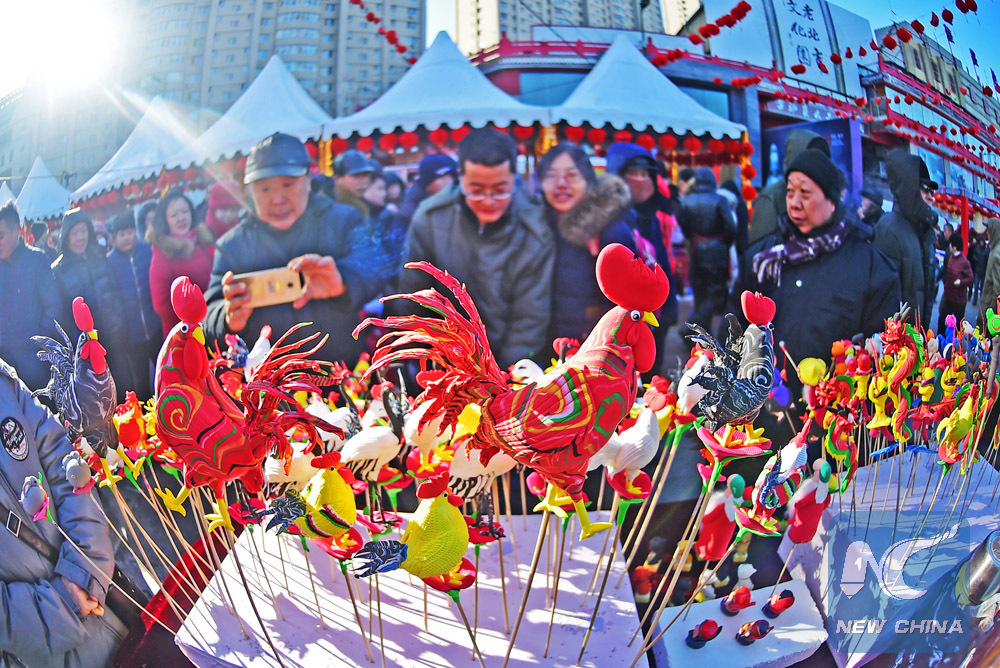
A man carrying a girl on his shoulder stands alongside a woman at a temple fair during the week-long Spring festival holiday in Shenyang, capital of northeast China's Liaoning Province, Jan. 30, 2017. (Xinhua/Yang Qing)
BEIJING, Feb. 4 (Xinhua) -- Despite great reluctance of many people, the joyous week-long holiday in celebrating the Lunar Chinese New Year, also known as Spring Festival, ended Thursday. Before the holiday that began Jan.27, people across China scrambled for tickets, traveled long distances from their work posts to their ancestral residences for family reunions. They had good days with family members, playing fireworks, going shopping and dining, visiting temple fairs or going to cinema. But good days go fast and too soon, they were on their way back home. A glimpse of highlights for this year's Spring Festival celebrations:
TRAVEL

Tourists visit a temple fair during the Spring Festival holiday in Shenyang, capital of northeast China's Liaoning Province, Jan. 30, 2017. (Xinhua/Yang Qing)
Like Christmas in the west, Spring Festival brings together separated family members. It has been a tradition in China that people who work away from their ancestral homes will return to their roots and spend the holiday staying at home, accompanying their parents or visiting friends and relatives.
But in recent years, the Chinese people have become increasingly keen to travel.
344 million tourist trips were made domestically during this year's seven-day Spring Festival holiday, up 13.8 percent year on year, according to the China National Tourism Administration.

Tourists visit a park during the Spring Festival holiday in Kaifeng, central China's Henan Province, Jan. 31, 2017. (Xinhua/Li An)
Data show that people from southern parts of China, where climate is warmer and more humid, chose to travel to the northeastern parts of the country to appreciate ice and snow spectacle and participate in various winter activities there, while many other people living in the cold north preferred flying to coastal southern provinces such as Guangdong and Hainan for a warm and sunny holiday.
That prompted China's tourism industry to take 423.3 billion yuan (61.6 billion U.S. dollars) in revenue during the holiday, a year-on-year increase of 15.9 percent.
In the meantime, 6.15 million Chinese people traveled abroad for the past Spring Festival holiday, up 7 percent year on year. Thailand, Japan and the United States were the top three most popular destinations.
DINING AND SHOPPING
Think of shopping mania on Christmas in western countries, it's the same here in China on Spring Festival. Whether it's buying new clothes for themselves for the new year, or gifts for the beloved ones, people rushed to shops and few came out empty-handed.
A reunion dinner, or "nianyefan" in Chinese, is also an indispensable part of celebrations for Spring Festival. It's usually held on the eve of the Lunar New Year when all family members gather together to be served to a big table of dishes at home, chatting and sharing stories while they were apart in the past year.

People view dough figurines at a temple fair during the week-long Spring Festival holiday in Shenyang, capital of northeast China's Liaoning Province, Jan. 30, 2017. (Xinhua/Yang Qing)
As people have become prosperous, more families now prefer to dine out in upscale restaurants and posh hotels.
Sales in catering and retail businesses reached 840 billion yuan during the Spring festiva holiday this year, up 11.4 percent year on year, data from the Ministry of Commerce showed.
Sales of folk artistic items in association with the Lunar New Year, jewelry, home appliances and digital commodities saw rapid growth, with rooster-themed accessories most favored by consumers as the holiday marked the start of 2017 the Year of the Rooster.

People purchase goods for the Spring Festival at a supermarket in Suining City, southwest China's Sichuan Province, Jan. 26, 2017. (Xinhua/Zhong Min)
There were many movies releases too, so this Spring Festival holiday was a also great occasion for movie lovers.
China's film market had box office takings of 3.347 billion yuan from Jan. 27 -Feb. 2, a new record high, according to industry figures.
RED ENVELOPES GO DIGITAL
In China, it has been a long tradition for elders to give out "hongbao," or cash-filled red envelopes to unmarried young people during Spring Festival. Red color symbolizes good luck and is believed to be able to ward off evil spirits.

A hongbao or red envelop sent on WeChat. (Xinhua/Guo Qiuda)
But nowadays it has been trendy that the lucky red envelopes have gone digital and they are given not only from elders to the unmarried young people but also among friends and relatives.
WeChat, China's major instant messaging app, said that some 14.2 billion red envelops were sent on WeChat on the eve of the 2017 lunar new year alone. Those who were born in the 1980s have sent and received the most red packets compared to those born in the 1990s and 1970s. WeChat data also showed that men tend to give out more hongbaos than women.
SAFER

Photo taken on Jan. 29, 2017 shows the a highway entrance during the Spring Festival travel rush in Qionghai, south China's Hainan Province. (Xinhua/Meng Zhongde)
Fewer accidents were reported during the week-long Spring Festival holiday this year, according to Ministry of Public Security.
The numbers of fire disasters and ensuing deaths dropped 11.8 percent and 26.4 percent, respectively, year on year. Also, the numbers of traffic accidents and related deaths and injuries fell 32.5 percent, 29.1 percent and 36.2 percent, respectively, year on year.

